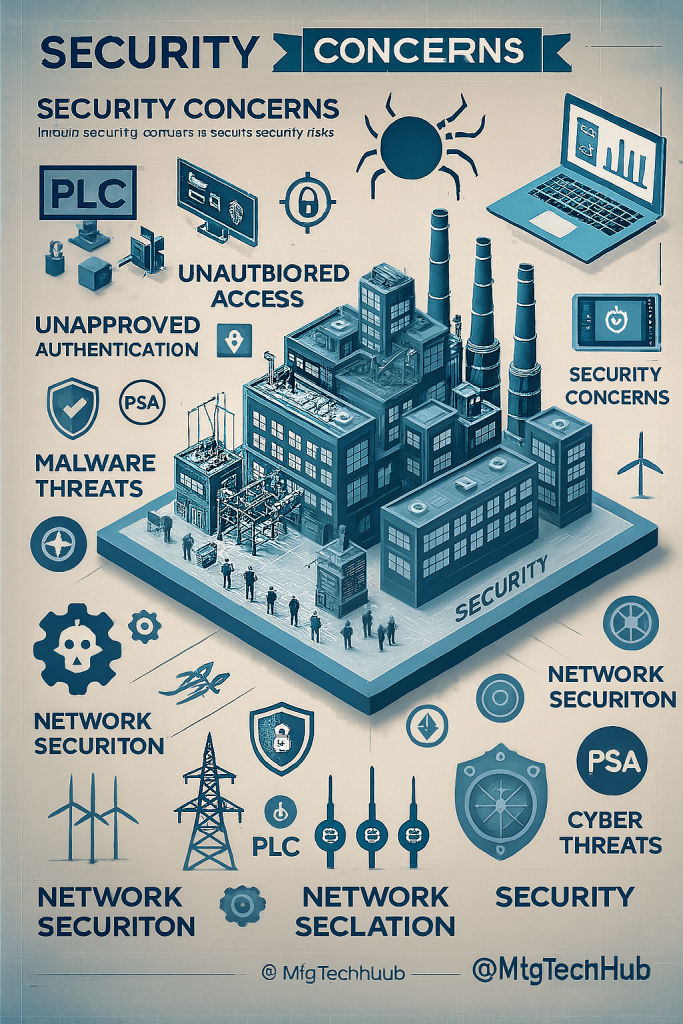Challenges and Considerations – Security Concerns
As Programmable Logic Controllers (PLCs) become more interconnected with the Industrial Internet of Things (IIoT), cloud computing, and remote monitoring, cybersecurity has emerged as a critical concern in industrial automation. Modern PLCs are no longer standalone systems; they are now integrated into smart factories, power grids, and critical infrastructure, making them prime targets for cyber threats.

This page explores common security risks in PLC systems, real-world examples of cyberattacks, and best practices for protecting PLC networks from security breaches.
1. Common Security Threats to PLC Systems
A. Unauthorized Access and Hacking Attempts
PLCs control essential industrial processes, making them attractive targets for hackers attempting to:
- Alter control logic to cause disruptions
- Steal sensitive operational data (e.g., production recipes, system configurations)
- Disable critical systems, leading to production shutdowns or equipment damage
Example: In 2010, the Stuxnet worm attacked Siemens PLCs controlling Iranian nuclear centrifuges, altering operational speeds and causing physical destruction without immediate detection.
Mitigation Strategy:
- Implement role-based access control (RBAC) to restrict unauthorized access
- Use strong passwords and multi-factor authentication (MFA) for remote logins
B. Malware and Ransomware Attacks
PLCs are vulnerable to malware infections via:
- Infected USB devices used by maintenance personnel
- Compromised software updates from unverified sources
- Unsecured network connections exposing PLCs to internet-based attacks
Example: In 2021, a ransomware attack on a US-based meat processing plant forced the company to shut down operations, causing millions in losses and supply chain disruptions.
Mitigation Strategy:
- Restrict USB device usage and enforce security scanning
- Ensure PLC firmware and software updates come only from verified manufacturers
- Segment PLC networks to prevent malware from spreading across systems
C. Insider Threats and Human Errors
- Disgruntled employees or contractors can intentionally alter PLC logic, causing production failures
- Accidental misconfigurations can expose vulnerabilities and compromise systems
Example: In 2015, an ex-employee of a US wastewater treatment plant remotely accessed the PLC system, altering chemical treatment settings and contaminating the water supply.
Mitigation Strategy:
- Monitor and log all access activities to detect suspicious behavior
- Implement strict employee offboarding policies, revoking access immediately after termination
- Use automation change management tools to track PLC program modifications
D. Network Vulnerabilities and Unsecured Communication
- Open network ports expose PLCs to cyber threats if accessible via the internet
- Outdated communication protocols (e.g., Modbus/TCP) lack encryption
- Weak firewall policies allow unauthorized devices to connect to PLCs
Example: In 2017, a cyberattack on Ukraine’s power grid remotely manipulated PLC-controlled substations, causing widespread blackouts affecting thousands of homes.
Mitigation Strategy:
- Use firewalls and virtual LANs (VLANs) to segment industrial networks
- Disable unused network ports and enforce strict IP whitelisting
- Encrypt PLC communication channels using secure protocols (e.g., OPC UA, TLS/SSL)
2. Strategies to Secure PLC Systems
A. Implement Strong Access Control Policies
Why? Unauthorized access is one of the leading causes of cyber incidents in industrial automation.
- Multi-factor authentication (MFA) for remote PLC access
- Role-based access control (RBAC) to grant permissions by job role
- Session timeout policies to log out inactive users automatically
Example: A pharmaceutical company using Siemens S7 PLCs implemented MFA and reduced unauthorized access attempts by 70%.
B. Regularly Update Firmware and Patch Vulnerabilities
Why? Unpatched PLCs are a security risk as they may contain known exploits.
- Schedule routine firmware updates from verified PLC manufacturers
- Apply security patches immediately upon release
- Maintain a backup of PLC configurations before updates for easy rollback
Example: In 2022, Rockwell Automation released an urgent patch to fix a vulnerability in its ControlLogix PLCs that could allow remote code execution.
C. Network Segmentation and Firewall Protection
Why? Network segmentation prevents malware from spreading across multiple PLCs.
- Isolate PLC networks from business IT networks using firewalls
- Create separate VLANs for production and non-production devices
- Use industrial intrusion detection systems (IDS) to detect unusual traffic
Example: A power plant in Europe implemented network segmentation, reducing cyberattack exposure by 80%.
D. Conduct Regular Security Audits and Penetration Testing
Why? Regular audits help identify vulnerabilities before attackers exploit them.
- Perform annual penetration testing to simulate cyberattacks on PLC networks
- Conduct security compliance audits based on ISA/IEC 62443 standards
- Keep detailed access logs to track unauthorized attempts
Example: A Japanese car manufacturer detected vulnerabilities in its robotic assembly PLCs through ethical hacking tests, preventing potential exploits.
E. Employee Security Awareness and Training
Why? Human error is a leading cause of cyber breaches in industrial settings.
- Train employees to identify phishing emails and social engineering attacks
- Implement USB device usage policies to prevent malware infections
- Encourage regular password updates and use of password managers
Example: A steel plant reduced security incidents by 60% after cybersecurity training for engineers and operators.
3. Future Trends in PLC Cybersecurity
- AI-Powered Threat Detection: Advanced AI-driven Intrusion Detection Systems (IDS) will automatically detect and mitigate cyber threats targeting PLCs.
- Zero-Trust Architecture for PLCs: Future PLC systems will adopt zero-trust security models, requiring continuous authentication for every action.
- Blockchain Security for PLC Networks: Tamper-proof blockchain-based logs will help secure industrial transactions and audit trails.
Key Takeaways
- PLCs are increasingly vulnerable to cyberattacks due to IIoT and remote connectivity
- Unauthorized access, malware, and network vulnerabilities are the primary threats to PLC security
- Implementing access controls, encryption, and network segmentation greatly enhances security
- Regular security audits and employee training are crucial for cyber resilience in industrial automation
Securing PLCs is no longer optional—it’s a necessity for preventing industrial cyber threats.
